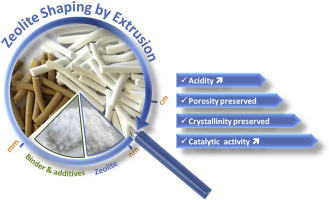Microporous and Mesoporous Materials ( IF 5.2 ) Pub Date : 2020-02-21 , DOI: 10.1016/j.micromeso.2020.110114 Louwanda Lakiss , Jean-Pierre Gilson , Valentin Valtchev , Svetlana Mintova , Aurélie Vicente , Alexandre Vimont , Robert Bedard , Suheil Abdo , Jeffery Bricker

|
Chemical interactions occurring between zeolites and alumina binders during the critical steps of catalyst forming are the focus of this study. Three widely used and commercially significant variants of FAU zeolite, covering a wide range of Si/Al ratios, micro- and meso-porosity and acidic properties (Y [LZY-64, Si/Al = 2.3] and USY [CBV 720 and CBV 760 with Si/Al = 16 and Si/Al = 28, respectively]) were shaped by extrusion with pseudoboehmite to produce bound extrudates. These extrudates were characterized by conventional techniques (XRD, 27Al NMR and IR spectroscopy, N2 physisorption...) and compared to their parent powders activated under the same conditions. The catalytic performances of the zeolite powders, their derived alumina extrudates and physical zeolite/γ-Al2O3 mixtures were also evaluated employing two different reactions: i) n-octane hydroisomerization, to probe all catalytic sites and ii) 1,3,5 tri-isopropyl benzene dealkylation to probe only the external/mesoporous surfaces. The bound zeolites systematically displayed catalytic performance superior to their parent powders or physical mixtures, especially in the dealkylation of 1,3,5 tri-isopropyl benzene. Infrared spectroscopy measurements of the number, nature and strength of the acid sites were consistent with these catalytic results demonstrating that new catalytic sites are created and located on the external or mesoporous surface of the zeolites, i.e. at the zeolite-binder interface. The work reported here clearly illustrates that binding and subsequent thermal treatment of zeolite powders to produce commercially representative forms can significantly alter the quality and quantity of active sites creating active centers not usually present in pure powders which are typically studied and reported in much of the open literature. Such a study is also a blueprint for other catalytic phases, other forming processes (spray-drying, oil-dropping, pelletizing…) and could also be applied to the shaping of adsorbents.
中文翻译:

良好形状的沸石:通过挤压形成的催化剂可改变其性能
在催化剂形成的关键步骤中,沸石与氧化铝粘合剂之间发生的化学相互作用是本研究的重点。FAU沸石的三种广泛使用且具有商业意义的变体,涵盖了广泛的Si / Al比,微孔和中孔率以及酸性(Y [LZY-64,Si / Al = 2.3]和USY [CBV 720和CBV分别用Si / Al = 16和Si / Al = 28的760]通过假勃姆石挤出成形以产生粘结挤出物。这些挤出物通过常规技术(XRD,27 Al NMR和IR光谱,N 2物理吸附……)进行表征,并与在相同条件下活化的母体粉末进行比较。沸石粉末的催化性能,其衍生的氧化铝挤出物和物理沸石/γ-Al系2还使用两种不同的反应评估了O 3混合物:i)正辛烷加氢异构化,以探测所有催化位点;ii)1,3,5三异丙基苯脱烷基,以仅探测外/中孔表面。结合的沸石系统地显示出优于其母体粉末或物理混合物的催化性能,尤其是在1,3,5三异丙基苯的脱烷基反应中。红外光谱测量酸性位点的数量,性质和强度与这些催化结果一致,表明新的催化位点已形成并位于沸石的外表面或中孔表面上,即在沸石-粘合剂界面。此处报道的工作清楚地表明,将沸石粉末粘结并随后进行热处理以生产具有商业代表性的形式,可以显着改变活性部位的质量和数量,从而形成通常在纯净粉末中不存在的活性中心,通常在许多公开场合进行研究和报道。文学。这项研究也是其他催化阶段,其他形成过程(喷雾干燥,滴油,造粒…)的蓝图,也可用于吸附剂的成形。



























 京公网安备 11010802027423号
京公网安备 11010802027423号